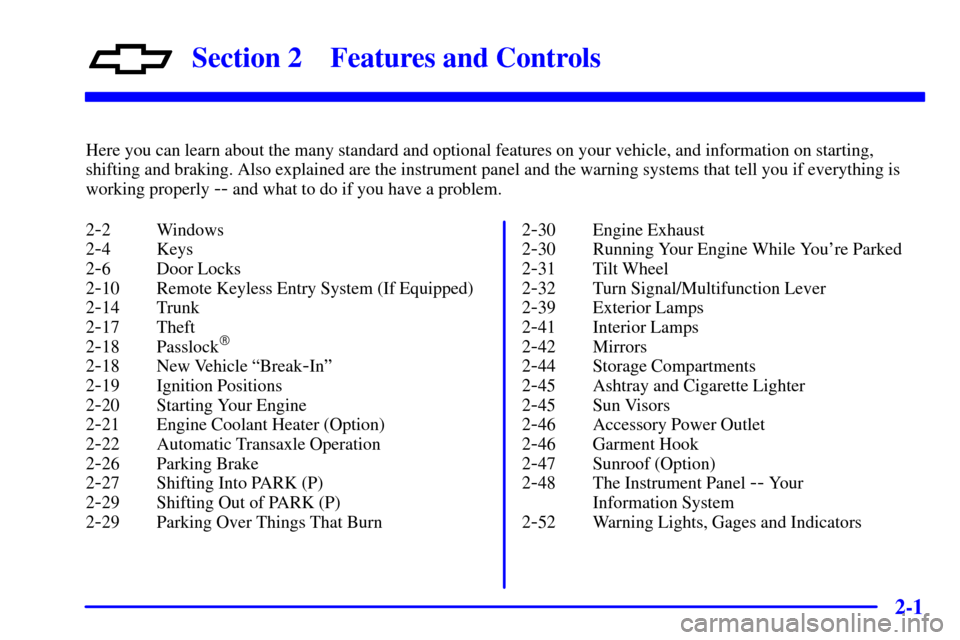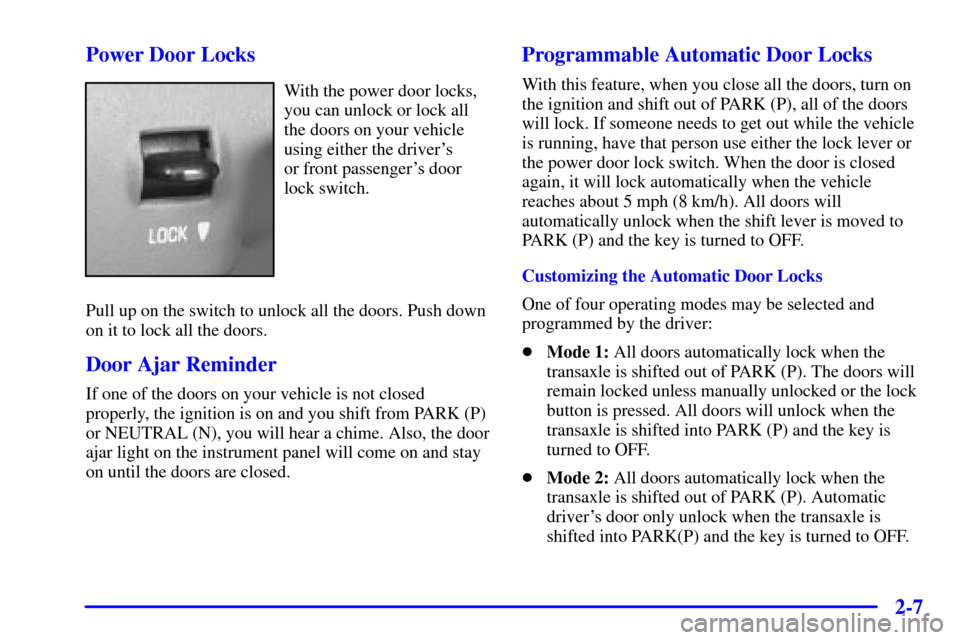Page 4 of 351
Table of Contents
Windows
Keys and Door Locks
Remote Keyless Entry System
Remote Trunk Release
Automatic Transaxle
Parking Brake
Tilt Wheel
Turn Signal/Multifunction Lever
Windshield WipersCruise Control (If Equipped)
Exterior and Interior Lamps
Mirrors
Storage Compartments
Convenience Net (If Equipped)
Accessory Power Outlet
Sunroof (Option)
Instrument Panel, Warning Lights and Gages Seats and Seat Controls
Safety BeltsSupplemental Restraint System (SRS)
Restraint Systems for Children
Section
1
Section
2
Seats and Restraint Systems
Features and Controls
ii
Page 11 of 351

ix
For example,
these symbols
are used on an
original battery:
CAUTION
POSSIBLE
INJURY
PROTECT
EYES BY
SHIELDING
CAUSTIC
BATTERY
ACID COULD
CAUSE
BURNS
AVOID
SPARKS OR
FLAMES
SPARK OR
FLAME
COULD
EXPLODE
BATTERY
These symbols
are important for
you and your
passengers
whenever your
vehicle is driven:
CHILD
RESTRAINT
TOP STRAP
ANCHOR
DOOR LOCK
UNLOCK
FASTEN
SEAT
BELTS
POWER
WINDOW
AIR BAG
These symbols
have to do with
your lamps:
MASTER
LIGHTING
SWITCH
TURN
SIGNALS
PARKING
LAMPS
HAZARD
WARNING
FLASHER
DAYTIME
RUNNING
LAMPS
FOG LAMPS
These symbols
are on some of
your controls:
WINDSHIELD
WIPER
WINDSHIELD
WASHER
WINDSHIELD
DEFROSTER
REAR
WINDOW
DEFOGGER
VENTILATING
FAN
These symbols
are used on
warning and
indicator lights:
ENGINE
COOLANT
TEMP
BATTERY
CHARGING
SYSTEM
BRAKE
COOLANT
ENGINE OIL
PRESSURE
ANTI-LOCK
BRAKES
Here are some
other symbols
you may see:
FUSE
LIGHTER
HORN
FUEL
Vehicle Symbols
These are some of the symbols you may find on your vehicle. Also see ªWarning Lights and Gagesº in the Index.
Page 24 of 351

1-12
Q:If I'm a good driver, and I never drive far from
home, why should I wear safety belts?
A:You may be an excellent driver, but if you're in an
accident
-- even one that isn't your fault -- you and
your passengers can be hurt. Being a good driver
doesn't protect you from things beyond your
control, such as bad drivers.
Most accidents occur within 25 miles (40 km)
of home. And the greatest number of serious
injuries and deaths occur at speeds of less than
40 mph (65 km/h).
Safety belts are for everyone.
How to Wear Safety Belts Properly
Adults
This part is only for people of adult size.
Be aware that there are special things to know about
safety belts and children. And there are different
rules for smaller children and babies. If a child will
be riding in your vehicle, see the part of this
manual called ªChildren.º Follow those rules for
everyone's protection.
First, you'll want to know which restraint systems your
vehicle has.
We'll start with the driver position.
Driver Position
This part describes the driver's restraint system.
Lap-Shoulder Belt
The driver has a lap-shoulder belt. Here's how to wear
it properly.
1. Close and lock the door.
2. Adjust the seat so you can sit up straight. To see
how, see ªSeatsº in the Index.
Page 66 of 351

2-
2-1
Section 2 Features and Controls
Here you can learn about the many standard and optional features on your vehicle, and information on starting,
shifting and braking. Also explained are the instrument panel and the warning systems that tell you if everything is
working properly
-- and what to do if you have a problem.
2
-2 Windows
2
-4 Keys
2
-6 Door Locks
2
-10 Remote Keyless Entry System (If Equipped)
2
-14 Trunk
2
-17 Theft
2
-18 Passlock�
2-18 New Vehicle ªBreak-Inº
2
-19 Ignition Positions
2
-20 Starting Your Engine
2
-21 Engine Coolant Heater (Option)
2
-22 Automatic Transaxle Operation
2
-26 Parking Brake
2
-27 Shifting Into PARK (P)
2
-29 Shifting Out of PARK (P)
2
-29 Parking Over Things That Burn2
-30 Engine Exhaust
2
-30 Running Your Engine While You're Parked
2
-31 Tilt Wheel
2
-32 Turn Signal/Multifunction Lever
2
-39 Exterior Lamps
2
-41 Interior Lamps
2
-42 Mirrors
2
-44 Storage Compartments
2
-45 Ashtray and Cigarette Lighter
2
-45 Sun Visors
2
-46 Accessory Power Outlet
2
-46 Garment Hook
2
-47 Sunroof (Option)
2
-48 The Instrument Panel -- Your
Information System
2
-52 Warning Lights, Gages and Indicators
Page 68 of 351
2-3 Manual Windows
On a vehicle with manual windows, use the window
crank to open and close each window.
Power Windows (If Equipped)
The power window switches are located on the armrest
on the driver's door. In addition, each passenger door
has a switch for its own window.Auto
-Down Switch
The driver's window also has an auto
-down feature.
This switch is labeled AUTO. Push the switch rearward
partway, and the driver's window will open a small
amount. If the switch is pushed all the way rearward,
the window will go all the way down.
To stop the window while it is lowering, push the
switch forward. To raise the window, push and hold
the switch forward.
Lock Out Button
The driver's power window controls also include a lock
out button. Press the LOCK OUT button to stop the
front and rear passengers from using their window
switches. The driver can still control all the windows
with the lock on. Press the LOCK OUT button again
for normal window operation.
Page 71 of 351
2-6
Door Locks
CAUTION:
Unlocked doors can be dangerous.
�Passengers -- especially children -- can
easily open the doors and fall out of a
moving vehicle. When a door is locked, the
handle won't open it. You increase the
chance of being thrown out of the vehicle in
a crash if the doors aren't locked. So, wear
safety belts properly and lock the doors
whenever you drive.
�Young children who get into unlocked
vehicles may be unable to get out. A child
can be overcome by extreme heat and can
suffer permanent injuries or even death
from heat stroke. Always lock your vehicle
whenever you leave it.
�Outsiders can easily enter through an
unlocked door when you slow down or stop
your vehicle. Locking your doors can help
prevent this from happening.
There are several ways to lock and unlock your vehicle.
From the outside, use your key or remote keyless
entry system.
From the inside, to lock the door, move the lock
lever forward.
To unlock the door, move the lock lever rearward.
Page 72 of 351

2-7 Power Door Locks
With the power door locks,
you can unlock or lock all
the doors on your vehicle
using either the driver's
or front passenger's door
lock switch.
Pull up on the switch to unlock all the doors. Push down
on it to lock all the doors.
Door Ajar Reminder
If one of the doors on your vehicle is not closed
properly, the ignition is on and you shift from PARK (P)
or NEUTRAL (N), you will hear a chime. Also, the door
ajar light on the instrument panel will come on and stay
on until the doors are closed.
Programmable Automatic Door Locks
With this feature, when you close all the doors, turn on
the ignition and shift out of PARK (P), all of the doors
will lock. If someone needs to get out while the vehicle
is running, have that person use either the lock lever or
the power door lock switch. When the door is closed
again, it will lock automatically when the vehicle
reaches about 5 mph (8 km/h). All doors will
automatically unlock when the shift lever is moved to
PARK (P) and the key is turned to OFF.
Customizing the Automatic Door Locks
One of four operating modes may be selected and
programmed by the driver:
�Mode 1: All doors automatically lock when the
transaxle is shifted out of PARK (P). The doors will
remain locked unless manually unlocked or the lock
button is pressed. All doors will unlock when the
transaxle is shifted into PARK (P) and the key is
turned to OFF.
�Mode 2: All doors automatically lock when the
transaxle is shifted out of PARK (P). Automatic
driver's door only unlock when the transaxle is
shifted into PARK(P) and the key is turned to OFF.
Page 73 of 351

2-8
�Mode 3: All doors automatically lock when the
transaxle is shifted out of PARK (P). No automatic
door unlock.
�Mode 4: No automatic door lock or unlock.
When your vehicle was shipped from the factory it was
programmed in Mode 1. To determine the current
mode of the vehicle or to change to a different mode,
do the following:
1. Ensure the shift lever is in PARK (P) and all doors
are fully closed throughout this procedure. Turn the
ignition to ON.
2. Press and hold LOCK on either power door lock
switch for 10 seconds. Release the switch when you
hear the chime.
3. Count the number of chimes you hear. The number
of chimes tells you which mode your vehicle is in.
You can change the mode by pressing and holding
LOCK on the power door lock switch (two chimes
for Mode 2, three chimes for Mode 3 and
four chimes for Mode 4).
4. Repeat Step 2 until you hear the number of chimes
that matches the mode you want.
The mode you selected is now set.Delayed Locking
This feature will allow the driver to delay the actual
locking of the vehicle. This feature will not operate if
the key is left in the ignition. See ªAnti
-Lockout
Protectionº later in this section.
When LOCK on the driver's power door lock switch is
pressed, with the key removed from the ignition and the
driver's door open, three chimes will be heard. The
doors will not lock. Seven seconds after the driver's
door has been closed, all of the doors will lock and the
parking lamps will flash twice. The horn will also chirp
if the horn chirp feature is enabled. See ªProgrammable
Horn Chirpº in the Index for more information.
If the driver opens another door before the
seven seconds, the doors will not lock until
seven seconds after the last door is closed.
If the power door lock switch is pressed to LOCK twice
when leaving the vehicle, or the LOCK button on the
remote keyless entry transmitter is pressed, the doors
will lock immediately.
If the power door lock switch is pressed to unlock, the
doors will unlock immediately and not lock
automatically after the doors are closed.